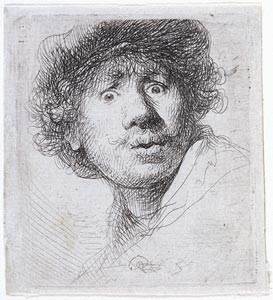
To celebrate the four-hundredth anniversary of the birth of Rembrandt Harmensz. van Rijn (1606–1669), The Morgan Library & Museum presented highlights from its exceptional collection of Rembrandt etchings. Pierpont Morgan laid the foundation for this collection—the finest in North America—when he acquired his first Rembrandt etchings from Theodore Irwin, Sr., in 1900 and George W. Vanderbilt in 1906. The Morgan holds impressions of most of the three hundred or so known etchings by Rembrandt, as well as multiple, often exceedingly rare impressions of various states. The exhibition showcased some of the most celebrated etchings in the collection, along with a few lesser-known and rarely exhibited examples.
Renowned in the history of printmaking, Rembrandt's etchings are famous for their dramatic intensity, penetrating psychology, and touching humanity. Celebrating his unsurpassed skill and inventiveness as a master storyteller, the exhibition addressed some of the central and often recurring themes of the master's work, including portraiture, the Bible, scenes from everyday life, the nude, and landscape.
Celebrating Rembrandt opens with a selection of Rembrandt's early portraits, created mostly while he was still a student in Leiden. His own face was often the focus of these spirited works, primarily exercises in lighting, technique, and, above all, expression. Sensitive renderings of the artist's own family—his elderly mother and first wife, Saskia—are also on display. Biblical depictions, the largest and arguably most important category of Rembrandt's etched work, are also featured. Subtle shifts in mood and meaning were illustrated in the different states of Christ Presented to the People and Christ Crucified Between Two Thieves ("The Three Crosses"). Other key highlights, such as Jacob Caressing Benjamin, Abraham Entertaining the Angels, and Abraham's Sacrifice, demonstrated the unique perspective Rembrandt brought to these biblical accounts. Also showcased was the Morgan's pristine impression of one of Rembrandt's most ambitious compositions, Christ Preaching, popularly known as "The Hundred Guilder Print."
Rembrandt was fascinated with the social outcast and those on the fringes of Dutch society. Key examples of this genre include Beggar Man and Woman Behind a Bank and Beggars Receiving Alms at the Door of a House. Among the depictions of individuals participating in everyday activities are The Skater and an example of a more earthy nature, The Monk in the Cornfield. In his later years, Rembrandt continued to produce striking, often introspective portraits, such as the Self-Portrait, Etching at a Window, of which the Morgan possesses the rare first and second states. Etchings of friends and contemporaries include Jan Six, the Dutch patrician and collector, who is depicted reclining gracefully against a windowsill, reading by sunlight.
A section on landscape etchings illustrated how Rembrandt captured the spirit of the Dutch countryside—often inserting charming hidden details—in works such as The Three Trees, Cottages and Farm Buildings with a Man Sketching, and Landscape with Trees, Farm Buildings, and a Tower.
Rembrandt Harmensz. van Rijn (1606–1669)
Self-Portrait in a Cap, 1630
Etching, B. 320, only state
51 x 46 mm
Gift of J. P. Morgan, Jr., 1924; RvR 442
